In the dynamic world of social media, the terms “content creator” and “influencer” are often used interchangeably. However, despite their overlapping functions, there are distinct differences and similarities between the two — especially when it comes to:
- Audience Engagement
- Monetization
- Brand Partnerships.
Defining Content Creators
Role
Content creators are individuals who produce original and engaging material across various platforms. Their primary focus is on creating content that resonates with their audience, whether it be through videos, blogs, photographs, podcasts, or other forms of media. Unlike influencers, whose main objective might be to influence purchasing decisions, content creators are more centered on storytelling, education, and entertainment.
Connection/Skills
Content creators are often seen as skilled artisans in their respective fields. Their connection with the audience is built on the quality and creativity of their content. They typically possess a deep understanding of their niche, and their skills may include photography, videography, writing, editing, graphic design, and more. This expertise allows them to craft unique and compelling content that stands out in a crowded digital space.
Impact
The impact of content creators is measured by the engagement and value they bring to their audience. While they may not always have the massive follower counts of influencers, their content often fosters a loyal and engaged community. The authenticity and originality of their work can lead to significant influence within their niche, driving trends and fostering a deep connection with their audience.
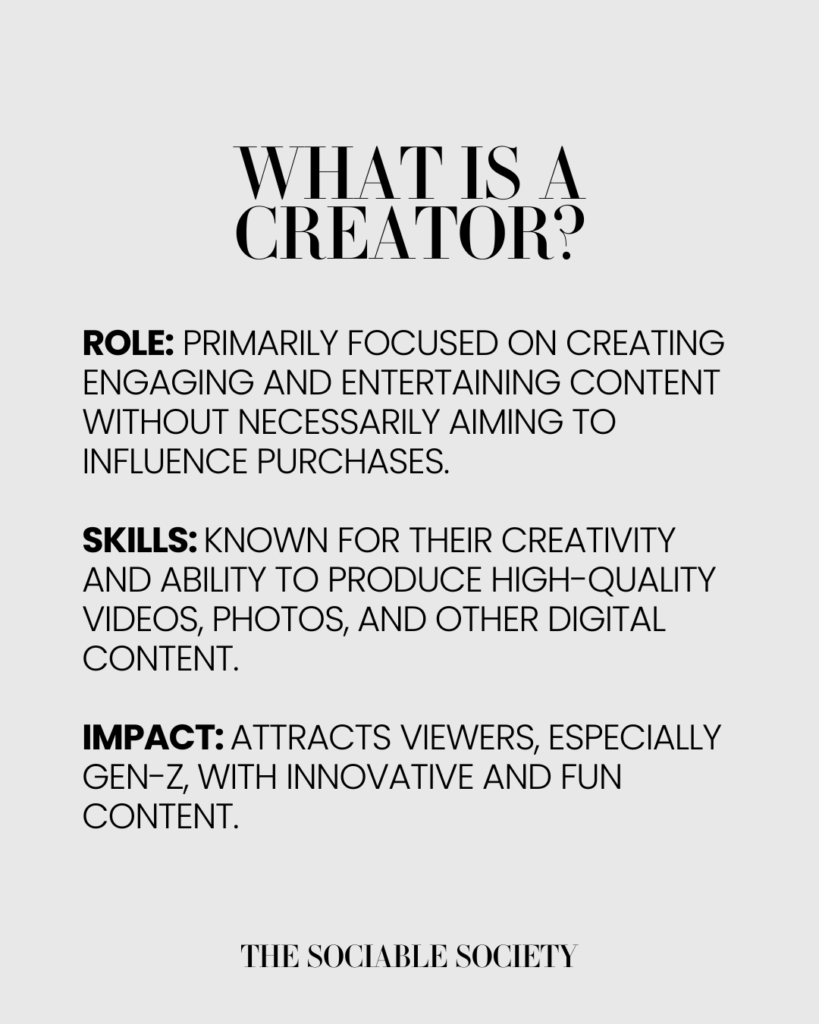
Defining Influencers
Role
Influencers, on the other hand, are individuals who leverage their social media presence to affect the purchasing decisions of their followers. They often collaborate with brands to promote products or services, using their platform to drive awareness and sales. While influencers also create content, their primary focus is on leveraging their influence to achieve specific marketing objectives.
Connection/Skills
Influencers excel in personal branding and audience engagement. Their skills lie in their ability to connect with their followers on a personal level, often sharing their lives, experiences, and opinions. This relatability builds trust and loyalty, which is crucial for influencing purchasing decisions. Influencers are adept at using social media tools and strategies to maximize their reach and impact.
Impact
The impact of influencers is typically measured by their reach and conversion rates. They have the power to sway public opinion and drive consumer behavior, making them valuable partners for brands. Their influence extends beyond their immediate followers, often shaping trends and conversations within their industry or niche.
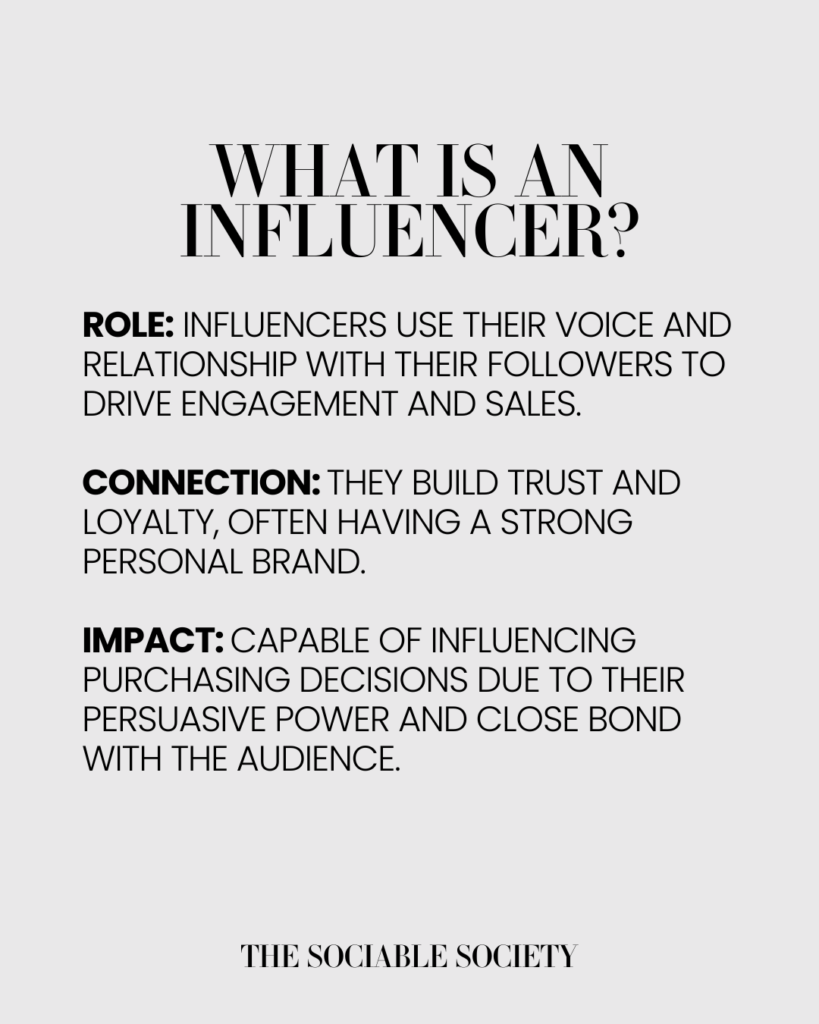
Similarities Between Content Creator vs Influencer
Despite their differences, content creators and influencers share several similarities:
1. Platform Utilization: Both use social media platforms to share their content and engage with their audience.
2. Community Building: They focus on building a community of followers who are interested in their content and perspectives.
3. Collaboration: Both often collaborate with brands, although the nature and purpose of these collaborations may differ.
4. Creativity: Creativity is at the core of what they do, whether it’s creating visually appealing content or crafting compelling messages.
Audience Engagement: Content Creators vs. Influencers
Audience engagement is a crucial metric for both content creators and influencers, but the way they approach and achieve it differs significantly.
Content Creators
Deep Connection Through Value-Driven Content
Content creators engage their audience by providing valuable, high-quality content that resonates deeply with their interests and needs. Their primary focus is on the content itself – whether it’s informative, entertaining, or inspirational. This approach helps build a loyal and engaged community that appreciates the creator’s expertise and creativity.
Content creators often spend a significant amount of time honing their craft and perfecting their content, which in turn fosters a strong, trust-based relationship with their audience.
Niche Communities
Content creators typically attract niche audiences who are specifically interested in the topics they cover. This specialization allows them to engage with their audience on a more personal and in-depth level. Content creators often become thought leaders within their niche, offering unique perspectives and insights that keep their audience coming back for more.
Engagement Metrics
For content creators, engagement is measured by the depth of interaction – comments, shares, and discussions – rather than sheer numbers. The quality of engagement often outweighs the quantity, with a focus on meaningful interactions that indicate a genuine connection with the audience.
Influencers
Broad Reach Through Personal Branding
Influencers, on the other hand, engage their audience through their personal brand and lifestyle. Their content is often more personality-driven, showcasing their daily lives, opinions, and endorsements. Influencers build their audience by sharing relatable and aspirational content that attracts a wide range of followers.
Broad Audience Appeal
Influencers tend to have a broader appeal compared to content creators. They reach a more diverse audience by covering a wide array of topics and trends. This broad appeal allows influencers to engage with a larger audience, making them attractive partners for brands looking to reach a wider demographic.
Engagement Metrics
The engagement metrics for influencers are typically focused on reach and visibility. Metrics such as likes, views, and follower counts are critical indicators of an influencer’s ability to engage with a large audience. Influencers often employ strategies to maximize their engagement rates, such as regular posting, interactive content, and collaborations.
Key Differences in Audience Engagement
1. Content Focus vs. Personal Branding: Content creators prioritize the value and quality of their content, leading to deep, meaningful engagement. Influencers focus on personal branding and lifestyle content, which can attract a broader audience but may result in less specialized engagement.
2. Niche vs. Broad Appeal: Content creators engage niche communities with specific interests, while influencers engage a wider audience with diverse interests.
3. Engagement Depth vs. Reach: Content creators measure success through the depth of engagement and meaningful interactions. Influencers often focus on reach and visibility, with engagement metrics centered around likes, views, and follower growth.
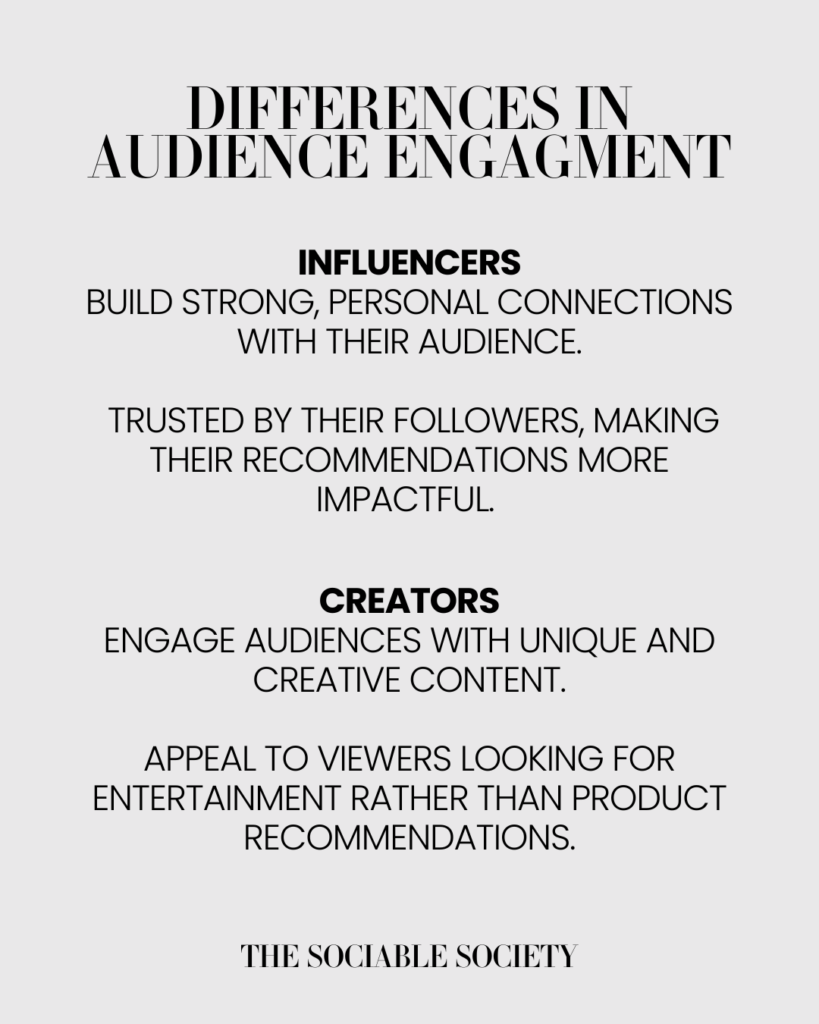
Monetization: Content Creators vs. Influencers
Monetization strategies are a critical aspect of both content creators’ and influencers’ careers. However, the approaches and revenue streams they utilize can vary significantly.
Content Creators
Diverse Revenue Streams
Content creators often have multiple streams of income, diversifying their revenue to ensure stability and growth. Content creators may earn money through:
- Ad Revenue: Platforms like YouTube and blogs offer ad revenue sharing, allowing creators to earn money based on the number of views and clicks their content generates.
- Sponsored Content: Collaborating with brands to create sponsored posts, videos, or articles that integrate the brand’s products or services in a way that aligns with the creator’s style and audience.
- Merchandise Sales: Selling their own branded merchandise, such as clothing, accessories, or digital products like eBooks and courses.
- Subscription Models: Utilizing platforms like Patreon or OnlyFans, where fans pay a monthly fee for exclusive content and perks.
- Affiliate Marketing: Earning commissions by promoting products or services and driving sales through affiliate links.
Creative Freedom
Content creators often prioritize creative freedom, which allows them to choose monetization methods that align with their content and audience values. This approach can lead to more authentic and engaging sponsored content, as creators are selective about the brands they partner with, ensuring a natural fit with their content.
Long-Term Value
The focus on quality and consistency helps content creators build a loyal audience over time, which can lead to sustainable income. This long-term value creation can attract premium sponsorship deals and loyal subscribers who are willing to support the creator financially.
Influencers
Brand Partnerships
Influencers primarily monetize their platforms through brand partnerships and sponsored posts. Tthese collaborations are often based on the influencer’s ability to reach a large and engaged audience, making them attractive to brands looking to increase visibility and sales.
- Sponsored Posts: Influencers are paid to create posts that feature a brand’s product or service, leveraging their personal brand to endorse and recommend the product to their followers.
- Brand Ambassadorships: Long-term partnerships where influencers represent a brand over an extended period, often involving multiple posts, appearances, and exclusive deals.
Event Appearances and Public Speaking
Influencers with significant followings and high visibility are often invited to attend events, speak at conferences, or participate in panel discussions. These appearances can be monetized through speaking fees, event participation payments, and travel sponsorships.
Performance-Based Models
Some influencers also utilize performance-based models, where they earn commissions based on the performance of their campaigns. This could include pay-per-click (PPC) or pay-per-sale (PPS) arrangements where the influencer’s income is tied to the success of their promotional efforts.
Product Lines
Influencers with strong personal brands often launch their own product lines, leveraging their influence to drive sales. This can range from fashion and beauty lines to fitness and lifestyle products.
Key Differences in Monetization
1. Diversity of Revenue Streams: Content creators often have more diversified income sources, including ad revenue, merchandise, subscriptions, and affiliate marketing. Influencers primarily focus on brand partnerships and sponsored content.
2. Creative Freedom vs. Brand Alignment: Content creators prioritize creative freedom, choosing monetization methods that align with their content. Influencers often align with brands for monetization, focusing on reach and visibility.
3. Long-Term Value vs. Immediate Impact: Content creators build long-term value through consistent, high-quality content that attracts sustainable income streams. Influencers often aim for immediate impact through high-reach sponsored campaigns and brand partnerships.
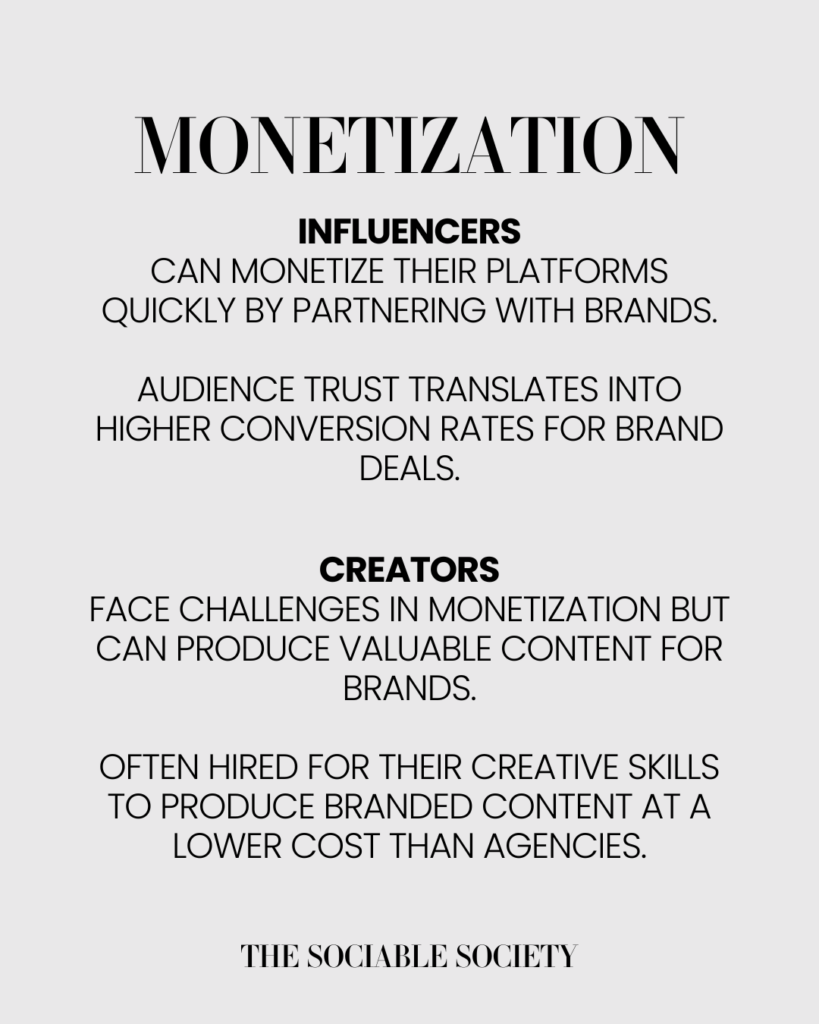
Brand Partnerships: Content Creators vs. Influencers
Brand partnerships are a cornerstone of monetization strategies for both content creators and influencers. However, their approaches to and relationships with brands differ significantly.
Content Creators
Selective Collaborations
Content creators are often more selective when it comes to brand partnerships. Their primary focus is on maintaining the integrity and authenticity of their content.
Content creators tend to partner with brands that align closely with their values, interests, and the interests of their audience. This selectiveness ensures that the collaboration feels natural and resonates well with their followers.
Storytelling and Integration
When content creators collaborate with brands, they excel at integrating the brand’s message seamlessly into their content. Their approach is often more storytelling-based, creating content that showcases the brand in a way that feels organic and engaging — this method of brand integration helps in building a genuine connection between the brand and the audience.
Long-Term Relationships
Content creators often build long-term relationships with brands, focusing on creating sustained value over time. These long-term collaborations allow creators to develop a deeper understanding of the brand and create more meaningful and impactful content — highlighting such relationships can lead to more authentic and effective brand endorsements, as the audience can see the creator’s consistent support for the brand.
Influencers
High-Volume Partnerships
Influencers typically engage in a higher volume of brand partnerships compared to content creators. Their primary goal is to leverage their broad reach and influence to promote products and services. Influencers often work with a variety of brands across different campaigns, aiming to maximize their revenue through frequent collaborations.
Direct Promotion
Influencers’ brand partnerships are often characterized by direct promotion. Their content is more likely to feature explicit endorsements and promotional messages. This approach is effective for driving immediate engagement and sales but can sometimes come across as less authentic. This direct promotional style can lead to higher visibility for the brand but may not always foster a deep connection with the audience.
Campaign-Specific Relationships
Influencers often engage in campaign-specific relationships with brands. These short-term collaborations focus on specific marketing campaigns or product launches. While this can lead to quick bursts of visibility and engagement, it may lack the long-term impact and authenticity that content creators offer. These short-term partnerships are valuable for brands looking to create immediate buzz and drive sales quickly.
Key Differences in Brand Partnerships
1. Selectiveness vs. Volume: Content creators are more selective with brand partnerships, ensuring alignment with their content and values. Influencers engage in a higher volume of partnerships to leverage their reach and maximize revenue.
2. Integration vs. Promotion: Content creators excel at seamlessly integrating brand messages into their content through storytelling. Influencers focus on direct promotion to drive immediate engagement and sales.
3. Long-Term vs. Short-Term: Content creators often build long-term relationships with brands, creating sustained value and deeper connections. Influencers typically engage in short-term, campaign-specific relationships to generate quick results.
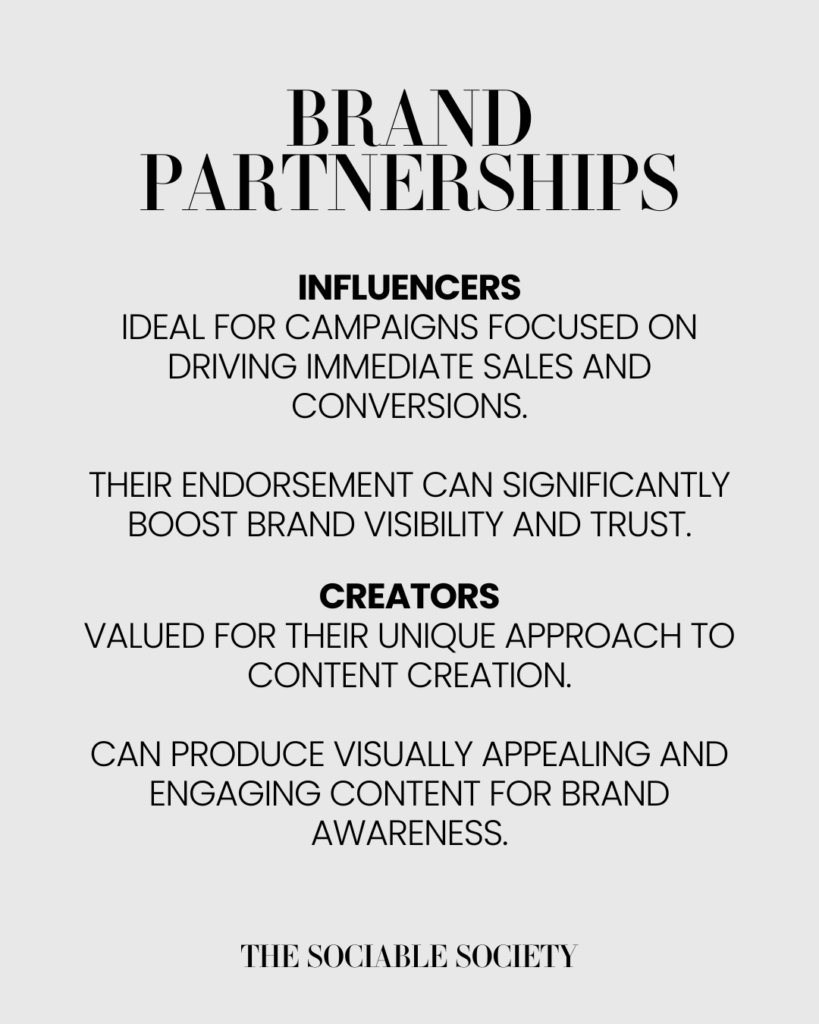
Influencer vs Content Creator: In Conclusion
Understanding the distinctions and similarities between content creators and influencers is crucial for brands and marketers aiming to effectively leverage social media. While both play significant roles in the digital landscape, their approaches to audience engagement, monetization, and brand partnerships differ in meaningful ways.
By recognizing the unique strengths of content creators and influencers, brands can develop more targeted and effective marketing strategies. Content creators provide depth and authenticity through high-quality, niche-specific content and long-term partnerships. Influencers offer broad reach and immediate impact through frequent collaborations and direct promotion.
Strategically partnering with both content creators and influencers allows brands to maximize their reach, engagement, and overall impact in the digital landscape. Whether the goal is to foster community engagement or drive broad-based awareness, understanding these roles’ distinct approaches can help brands achieve their marketing objectives more effectively.